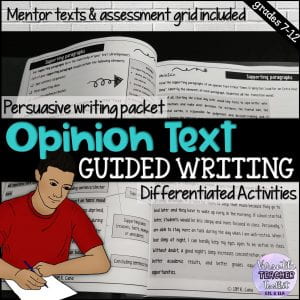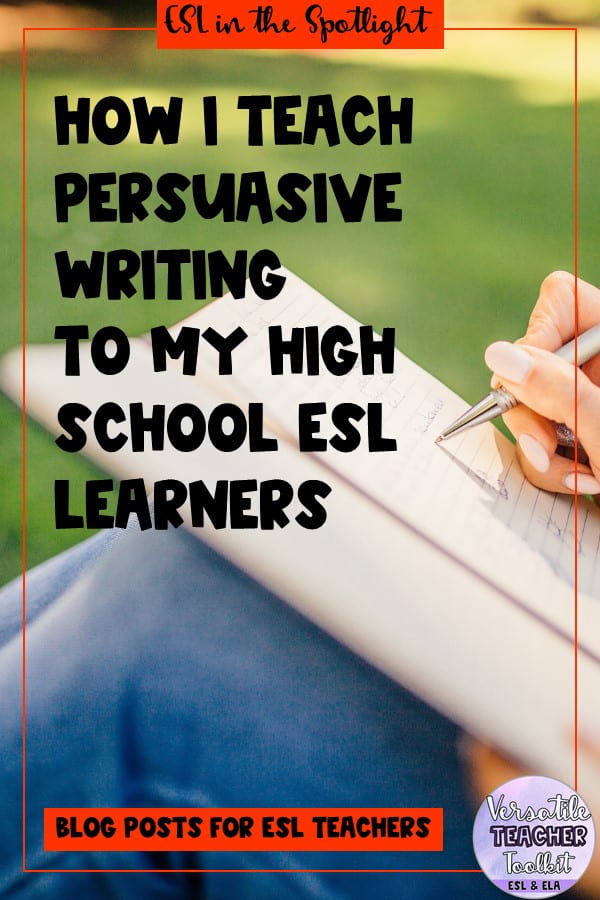On the first day of school two years ago, I asked my Grade 10 ESL learners what aspect of English class they considered the most challenging. The answer was writing. They found writing difficult because they were short of ideas. Indeed, to have enough ideas, ESL learners need to read and collect information from various sources. That is why I hardly ever assign writing prompts out of context. Generally, I give my students writing prompts based on a text, video or multiple texts we have read in class, so they can skillfully select, organize and reinvest new information and language in an original written production. Of course, it is important to nurture students’ creativity and allow them to use their imagination by offering them quick writes or creative writing projects. However, when teaching a specific genre of writing in a mixed-ability classroom or to teenagers with learning difficulties, direct instruction and guided writing practice are always my go-to approaches. Even though I know that persuasive writing is a genre that students have certainly discussed in Grade 9, I never assume that they all know how to properly write an opinion piece when they arrive in Grade 10 or 11.
PERSUASIVE WRITING WORKSHOP
When I teach persuasive writing in my Grade 10-11 classes, I use different sources to model the art of persuasion. By exposing learners to varied text types and offering them different kind of activities during our writing workshop, they are not only developing writing skills, but also other ESL competencies/skills such as oral interaction (speaking) and reinvestment of understanding of texts (reading and listening skills). Moreover, I also find important to choose a topic that appeals to the student population. For instance, most teenage learners are often tired and sleepy in class, but little might they know about the scientific reasons behind their constant fatigue. That is why I like to introduce my writing workshop on persuasive writing with a discussion about sleep deprivation leading to the guiding question: Should the school day start later?. This is an issue that teenagers can personally relate to.
Once learners have shared their personal experience about being sleep-deprived teens, I continue with a TED Talk presentation to engage them and have them gather information for the opinion text they need to write at the end of the workshop. I usually show students one of my favourite TED Talks and excellent persuasive speech, Why school should start later for teens by Wendy Troxel. Of course, before watching, I set the purpose for listening by asking students to draw a T-chart in their notebook, so they can record all the advantages and disadvantages of starting the school day later while watching the video. I also invite them to pay attention to the techniques the speaker is using to grab their attention at the beginning, the way she is introducing her thesis and arguments, and the way she is closing her speech. I also remind learners to particularly pay attention to the end of the video when the speaker is inviting her audience to reflect on the issue raised in her presentation.
Data provided by TED
After watching, learners share their observations about the techniques used to persuade the audience, possibly administrators, politicians and people who have the power to change things in the community. Then, we also discuss the pros and cons they have recorded in their notebook. Discussing Wendy Troxel's speech as a whole class is not only an opportunity to assess learners’ understanding, but it also helps weaker learners jot down some ideas they might have missed while watching. After the whole-class discussion, I like to put students in small discussion teams (2 or 3 students) and ask them to list more examples of pros and cons from their experience.
After carrying out this activity, learners continue working in small teams. To gather more information about the issue, I assign them two short articles in which they have to find the most relevant ideas to complete their pros and cons list. Of course, you may also assign this activity as individual work if you prefer so.
I usually select articles related to the issue from the website newsela.com where you can choose the difficulty level of the texts, thus, they are ideal for differentiation. These articles are for ELA learners, but most of the texts are suitable for ESL students, as well. You will have to create an account to get access to the content, but their basic account is free. Here are some selected articles from the website Newsela that you may assign to your learners, but you can also find a lot of other relevant articles online:
- Later to rise, not earlier to bed, for today's tired teens, doctors say
- Later start times, less homework to help students cope with stress
- Study shows kids' brains work better with more naps
- Giving schools a later start would create a huge financial benefit
- New research on deep sleep helps solve the mystery of memory
By now, students’ pros and cons list should contain enough ideas. Well, they might have enough meet to work with, they still need to know how to organize their ideas coherently. So, this is the moment when I walk learners through the structure of a persuasive/opinion text using direct instruction and guided writing practice.
DIRECT INSTRUCTION AND GUIDED WRITING PRACTICE
Wendy Troxel’s presentation is an exemplary persuasive speech that students can learn so much from, but I want to expose them to written works, as well. I usually use two mentor texts. One of them is a short text helping even my struggling learners to grasp the most important elements of a well-structured opinion piece, the other one is a more developed text in response to our writing prompt: Should the school day start later?.
The reason why I would want to give my students mentor texts written on the same issue is not only a personal choice, but it is also a differentiated learning technique to offer learners all the possible avenues for developing good writing skills. On the one hand, I can use these mentor texts to model content, structure and language. On the other hand, opinion text models on the same issue will give struggling writers more confidence when they need to produce their own piece of writing at the end of the workshop. If you worry about students copying the exact sentences from these texts, state your expectations clearly, and everything should be fine.
Whenever I guide my students through the steps of writing an opinion piece, I use the opinion text guided writing workbook I have designed for my ESL learners and have improved over the years.

This resource is a deconstructed step-by-step guide assisting students in writing introductions, formulating clear opinions on an issue, writing supporting paragraphs and conclusions. Of course, depending on my students’ needs, I might need to spend more or less time on analyzing the structure of an opinion text or on completing the guided writing activities in this resource. You may check out this Opinion/Persuasive Text Guided Writing Workbook here.
By the end of this writing workshop, learners should have acquired all the necessary skills to confidently write their opinion piece in which they answer the guiding question proposed at the beginning of our workshop: Should the school day start later?
If you want to read more about how I teach the response process using videos, click here.
I would be glad to hear about the way you organize your writing workshops when teaching persuasive writing. Please share your ideas in the comment section.
Happy teaching!
Kynga C.

Thank you for stopping by TpT store!
⇰ TpT store: VERSATILE TEACHER TOOLKIT ESL AND ELA RESOURCES
⇰ Visit the ESL in the Spotlight BLOG and join my mailing list to stay updated on teaching tips, resources and other ELL goodies.
⇰ Let's connect on PINTEREST and FACEBOOK
Join The Best of Teacher Entrepreneurs Marketing Cooperative at
http://www.thebestofteacherentrepreneursmarketingcooperative.com/2014/01/the-best-of-teacher-entrepreneurs.html and get THOUSANDS OF PAGE VIEWS for your TpT products!
Go to http://www.pinterest.com/TheBestofTPT/ for even more free products!


Nurturing persuasive writing skills in my high school ESL learners is a rewarding journey. Tailored lessons, real-life examples, and creativity empower them to articulate compelling arguments and excel academically. - editinghelp.co.uk
ReplyDelete